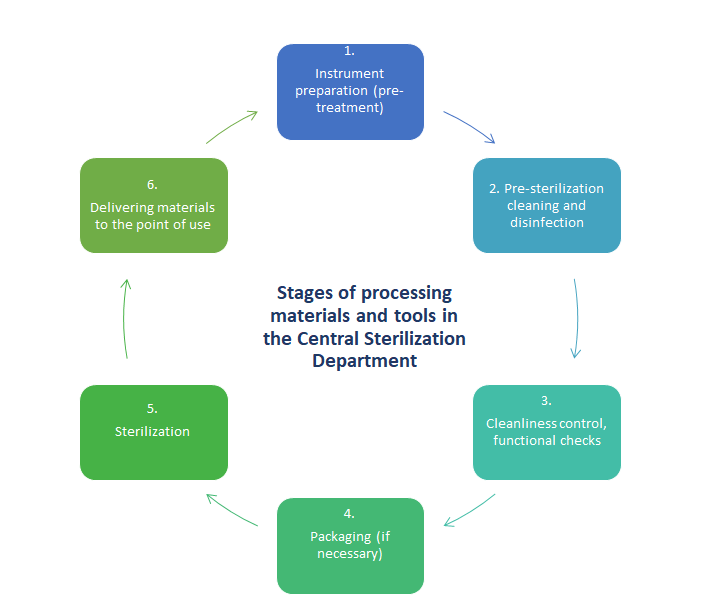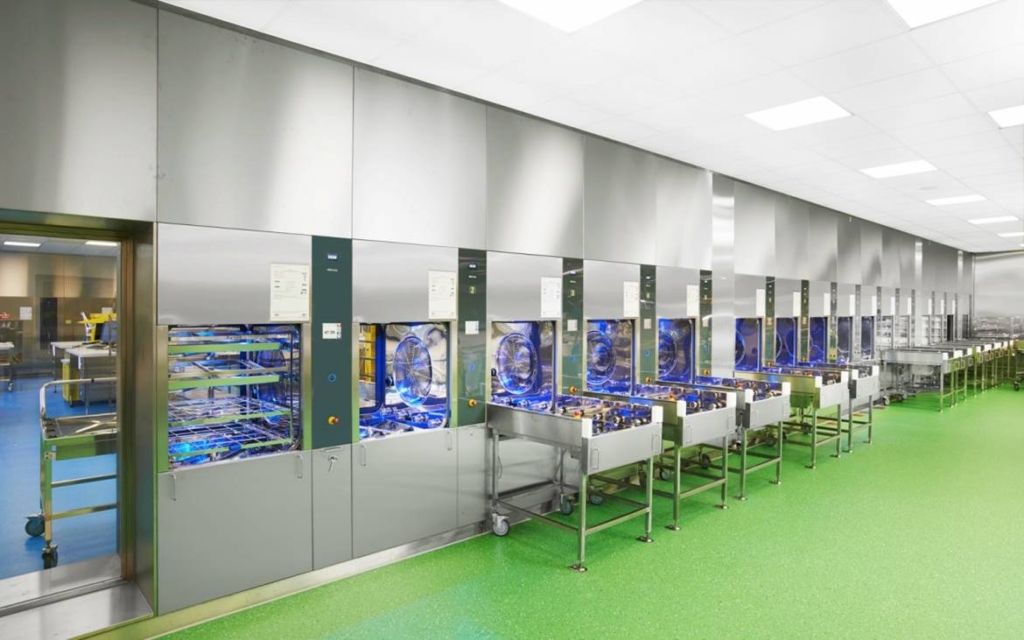Central Sterilization Department
Medico-Innovation Technologies
Medical Innovative Technologies offers a complete solution for the creation of a Central Sterilisation Unit (CSU) in a healthcare organisation. The CSU is a structural unit that is a part of large medical institutions in special and general practice.
The CSU is a technical facility that operates in a special mode to ensure timely and sufficient decontamination of instruments, dressing and suture material, linen, as well as medical equipment.
The structure of the central sterilisation unit is tailored to the specific nature of the healthcare facility and the volume of items coming in for sterilisation. The CSU is planned in such a way as to optimise the time required to carry out technological operations and to eliminate possible errors due to the so-called "human factor".
The organization of the central sterilization department solves the tasks of creating sanitary zonality: achieving absolute sterility in the autoclave room and in the warehouse of materials prepared for delivery, as well as maintaining increased sterility in conditionally clean zones. Dirty areas are separated from clean and sterile sanitary facilities and function without direct contact with them.
Procedure for the operation of the CSU
Medical supplies move from the dirty area to the sterile area and from the sterile area to the clean area.
Special sanitary regimes in the CSU eliminate the free movement of personnel and items from one area to another, which, together with strict compliance with the sequence of cleaning of items, virtually eliminates the "human factor".
The composition of the central sterilisation department, organised according to the typical principle, includes functional rooms and sectors of three types.

The "dirty area" includes: Material reception, Manual instrument washing, Automatic washing machines (Washing and disinfection machines).
The heart of the central sterilisation department is the sterilisation room and the sterile storage area. In some cases, the sterile storage room is supplemented by rooms (segregated sectors) for repair and sharpening of instruments as well as stacking and packaging of materials and linens.

The clean area of the CSU starts immediately after the sterile area and includes: an area for picking up materials before dispensing and an area for dispensing sterile items connected to the clean trolley storage area.
In addition, the clean area includes various auxiliary rooms and storage areas (staff room, chemical storage, packaging material storage, etc.).
Benefits of CSU
-
High reliability of sterilization due to the centralized organization of all stages, including effective pre-sterilization cleaning, on which the quality of subsequent sterilization depends;
-
Rational use of expensive high-quality equipment and materials;
-
Reducing the cost of sterilization in the CSU by about three times compared to the local method, as it simplifies the control over the condition of the equipment, reduces operating costs and costs for sterilization;
-
Sterilization quality control is easier and more convenient due to the automation of the process in the CSU;
-
The release of medical staff for more productive work.
Modern requirements for the design of the CSU
-
The central sterilization department should be designed as a whole. The layout of the premises, the composition of the equipment and the scheme of engineering communications are formed in such a way as to ensure maximum mid-ergonomics of all work processes and not violate the established procedure for the functioning of the CSU;
-
The central sterilization department should be equipped with the most efficient equipment. Many designers pay special attention only to productivity, completely forgetting about efficiency - the totality of equipment performance, which is absolutely unacceptable;
-
Furniture, which is equipped with a central sterilization department, should be given no less attention. For the needs of sterilization departments, special tables and tables with lighting have been developed, which should not be replaced by any other. General lighting should provide good visibility, but not be too bright.

Equipment for CSU
-
In order for the CSU to be able to fully fulfill the tasks assigned to it, it must be equipped with modern technical means, selected for specific needs, and staffed with a staff of trained specialists capable of properly operating the technical means entrusted to them;
-
The most common technical means, which are available in 99% of the CSU, include: a steam sterilizer, a washing bath, a disinfection boiler, a drying cabinet, a plasma sterilizer, a water distiller, a thermal sealing machine, a purified water storage tank, a washer-disinfection machine, as well as various equipment for transportation and storage. The composition of the equipment changes little, only its performance differs;
-
The performance of sterilization and auxiliary equipment is calculated at the design stage of the CSU, based on the individual characteristics of a particular medical institution (they are determined by workload and profile).


